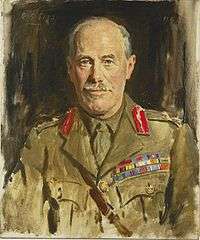William Norman Herbert
| William Norman Herbert | |
|---|---|
 | |
| Born | 1880 |
| Died | 1949 (aged 68–69) |
| Allegiance |
|
| Service/ |
|
| Years of service |
1900–1939 1939–1940 |
| Rank | Major General |
| Unit | Northumberland Fusiliers |
| Commands held |
1st Battalion, Northumberland Fusiliers 10th Brigade 50th (Northumbrian) Infantry Division 23rd (Northumbrian) Division |
| Battles/wars |
Second Boer War World War I World War II |
| Awards |
Companion of the Order of the Bath Commander of the Order of St Michael and St George Distinguished Service Order & Bar |
Major General William Norman Herbert, CB, CMG, DSO & Bar DL (1880–1949) was a senior British Army officer who served as colonel of the Northumberland Fusiliers and commanded the 23rd (Northumbrian) Division in the Battle of France during the Second World War.
Military career
Herbert entered the Royal Military College, Sandhurst where he was commissioned as a second lieutenant into the British Army's Northumberland Fusiliers on 11 August 1900.[1] He saw active service in the Second Boer War from later that year, and was promoted to lieutenant on 12 December 1901.[2] Following the end of the war in June 1902, he returned to the United Kingdom on the SS Europan which arrived at Southampton in early September.[3]
He served in the First World War as Commanding Officer (CO) of the 1st Battalion, Northumberland Fusiliers in which capacity he captured an enemy position together with fifty-nine prisoners for which he was awarded a bar to his Distinguished Service Order in January 1919.[4]
After attending the Staff College, Camberley,[5] he became a staff officer at Northern Command in 1930,[6] commander of 10th Brigade in March 1932 and General Officer Commanding (GOC) 50th (Northumbrian) Infantry Division in February 1935.[7] He was appointed a Companion of the Order of the Bath on 1 January 1935[8] and colonel of the Northumberland Fusiliers on 5 July 1935.[9]
Although he retired in February 1939, he was recalled during the Second World War as GOC 23rd (Northumbrian) Division to lead the deployment of that formation as part of the British Expeditionary Force (BEF) in the Battle of France in April 1940.[10] He retired for a second time when the division was disbanded on 30 June 1940.[10]
He settled in Worcestershire, and became Deputy Lieutenant for the county from 1946 until his death three years later in 1949.[11]
References
- ↑ "No. 27219". The London Gazette. 10 August 1900. p. 4947.
- ↑ Hart´s Army list, 1903
- ↑ "The Army in South Africa - Troops returning home". The Times (36858). London. 28 August 1902. p. 9.
- ↑ "No. 31119". The London Gazette (Supplement). 10 January 1919. p. 578.
- ↑ Smart, p. 149
- ↑ "William Norman Herbert". Generals.dk. Retrieved 7 February 2016.
- ↑ "Senior Army Commands" (PDF). Retrieved 7 February 2016.
- ↑ "No. 34238". The London Gazette (Supplement). 1 January 1935. p. 3.
- ↑ "Colonels". British Empire. Retrieved 6 February 2016.
- 1 2 "23rd (Northumbrian) Division". Unit Histories. Retrieved 7 February 2016.
- ↑ Smart, p. 150
Bibliography
- Smart, Nick (2005). Biographical Dictionary of British Generals of the Second World War. Barnesley: Pen & Sword. ISBN 1844150496.
| Military offices | ||
|---|---|---|
| Preceded by Sir Percival Wilkinson |
Colonel of the Royal Northumberland Fusiliers 1935–1947 |
Succeeded by Harold Morgan |
| Preceded by Richard Pope-Hennessy |
GOC 50th (Northumbrian) Infantry Division 1935–1939 |
Succeeded by Giffard Martel |
| Preceded by New post |
GOC 23rd (Northumbrian) Division 1939–1940 |
Succeeded by Post disbanded |